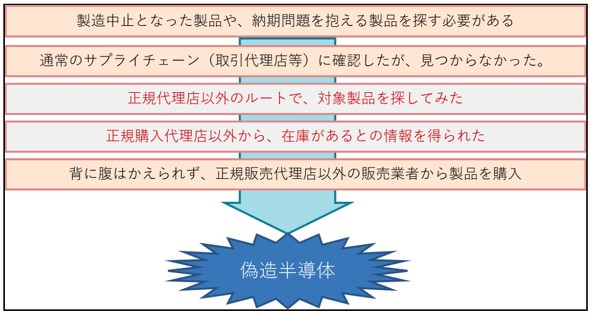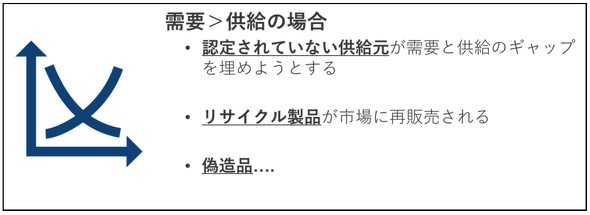What are the different types of counterfeit chips, and how to avoid falling into traps?
01 Why Do Counterfeit Chips Get Purchased?
First of all, Figure 1 illustrates the typical process of purchasing counterfeit chips.

Figure 1: The process of buying a fake chip
Ordinarily, enterprises purchase the required quantity of chips on-demand based on the production plans of their end products. However, affected by a sharp surge in demand or
changes in supply-side conditions, a situation may arise where they cannot secure the necessary quantity. At this point, to maintain the production of end products, it becomes
imperative to procure as many chips as possible and as quickly as possible.
In such cases, it is often difficult to purchase genuine chips through formal channels with existing contracts. Naturally, to mitigate risks, enterprises usually prepare multiple secure
procurement channels and verify inventory levels and supply feasibility for each respectively. But when chips cannot be sourced through any of these channels, they have no
choice but to seek alternative ways to acquire the chips.
Unlike in the past, there is now a wealth of information available on the internet. A simple search will reveal numerous suppliers claiming to have chips in stock. Nevertheless, most
of these suppliers have no prior transaction records, making it hard to determine whether their inventory consists of genuine products. Furthermore, such suppliers typically do not
disclose detailed information, leaving enterprises with no option but to make procurement decisions based on limited information. While continuing to search for reliable
channels, the delivery deadline becomes increasingly urgent. Even after repeated attempts to contact existing channels yield no progress, enterprises are ultimately forced to take
a risk and purchase from suppliers with insufficient information—only to later find that the chips procured are confirmed to be counterfeit.
In this way, when the market experiences a supply-demand imbalance, the trade of counterfeit chips tends to increase significantly.

Figure 2: Conditions for the Emergence of Counterfeit Chips
What happens when demand outstrips supply?
In theory, there should be no extra chips beyond the quantity produced by original manufacturers. However, at such times, some suppliers uncertified by semiconductor
manufacturers emerge. That is to say, they cannot obtain semiconductors through formal channels. So, how do these suppliers get their hands on chips?
One simpler and lower-cost method is to acquire "recycled products". These recycled items are not regular market-circulated goods; instead, they are used chips removed from the
circuit boards of end products that were discarded for various reasons. Although these chips were initially manufactured by the original factory and have the same specifications as
genuine ones, they were once mounted on circuit boards and used for a period of time. There are significant risks, ranging from the reliability of the package pins to the reliability of
the chips themselves, making it difficult to ensure the safety of their continued use.
When chip supply is tight, counterfeit chips proliferate even more. For instance, some counterfeit chips look identical to genuine ones in appearance, but there is no actual chip
inside the package, or the leads are not connected. In some extreme cases, completely different chips are even re-marked to pass off as the target product.
In the past, there have been cases where the use of such counterfeit chips caused large-scale malfunctions in the market. In one such case, the package had reliability issues, which
allowed chloride to seep into the chip and corrode it, leading to operational failures. In the end, all circulating end products on the market had to be recalled, resulting in significant
losses.
02 Which Types of Chips Are More Prone to Counterfeiting?
So, what exactly makes certain chips more prone to counterfeiting? As mentioned earlier, when demand outstrips supply, counterfeit chips tend to circulate in the market. Here, we will first analyze which chips face a higher risk of counterfeiting based on their product life cycles. Figure 3 illustrates the typical life cycle of a chip and the likelihood of it being counterfeited.
First, let’s look at current chip products that are still in the mass production phase. Starting from the design stage, a production plan for chips is formulated based on demand
forecasts, and manufacturing is carried out in accordance with this plan. However, the actual market performance of some chips may far exceed expectations, with demand surging
well beyond the initial forecast. In such cases, the production system may not be able to expand in a timely manner, leading to a situation of supply shortage. Nevertheless, since
these chips are still being continuously manufactured, even if there is a temporary shortage, this deficit will gradually be alleviated over time.
Next, we need to focus on chips that have been discontinued and entered the MRO (Maintenance, Repair and Operations) phase. Generally speaking, when planning and selling end
products, manufacturers will preset the product’s sales cycle and determine the product life cycle based on this. Correspondingly, the procurement plan for the chips used in end
products is also formulated in advance—specifying when and how many chips to purchase. Additionally, when the end product’s life cycle ends, to provide user support,
manufacturers need to prepare an additional quantity of chips for subsequent maintenance and repair work.
However, due to changes in market demand, these procurement plans are rarely flexible enough to be adjusted or managed with precision. In particular, once an end product
reaches the end of its life cycle, it becomes nearly impossible to predict exactly how many more chips will be needed. This depends not only on the lifespan of the chips themselves
and the demand within the preset maintenance cycle, but also is significantly influenced by users’ actual usage conditions. Users’ usage patterns are often unpredictable, and in
some cases, a much larger number of replacement chips than expected may be required. On the other hand, product sellers want users to upgrade to new models as soon as
possible, while users tend to "keep using the product as long as it works" and demand continuous maintenance support during its usage period. As a result, the actual number of
chips needed is likely to far exceed initial expectations.
The life cycle of a chip is relatively shorter than that of the end product it powers. Therefore, when the end product’s life cycle ends, the semiconductor is often already
discontinued, making it impossible to place additional orders with the original manufacturer. At the same time, distributors struggle to hold large inventories for an extended
period, and sometimes have no inventory at all. This leads to a shortage of chip supply.
At this point, the balance between supply and demand is completely disrupted, forcing manufacturers of end products to resort to various means to source chips.
And this is precisely the fundamental reason for the proliferation of counterfeit chips.
03 What Are Counterfeit Chips?
So, what exactly are the so-called counterfeit chips? According to the definition of the WSC (World Semiconductor Council), they refer to illegal products that are passed off as genuine ones during the manufacturing, modification, distribution, or supply process. To elaborate specifically, counterfeit chips can be categorized into the following types:
Products replicated by reverse-engineering original semiconductors, without the permission of the original supplier.
Products that resemble original semiconductors in appearance, function, or specifications but only superficially, and do not truly meet the specifications listed in the data sheet.
Products with unknown manufacturers.
Products that were originally manufactured by the original supplier but were supposed to be discarded during the production process, or have been used but are resold as new.
Products that are made to look like genuine ones by altering their part numbers or package markings.

Figure 4: What is a fake chip?
For a more systematic understanding, counterfeit chips can be categorized into six major types:
【Recycled Products】
The so-called recycled counterfeits refer to semiconductors that are disassembled from discarded, used printed circuit boards (PCBs), then repackaged and sold as new products.
This category includes semiconductors that are completely non-functional or that fail after a short period of use.
【Relabeled Products】
These are counterfeit chips where the original markings on the package (or chip itself) are removed and replaced with new ones. For instance, consumer-grade semiconductors
are disguised as industrial-grade or military-grade ones, which are then sold as higher-specification products.
It is reported that these two types together account for more than 80% of all counterfeit chips.
【Out-of-Spec/Damaged Products】
This category refers to counterfeit semiconductors that are either "out of specification" or "damaged". These semiconductors should have been discarded for failing to meet
application requirements or product specifications, but are instead maliciously recovered and resold.
【Cloned Products】
These are semiconductors not developed based on legitimate information. To cut development costs, counterfeiters only copy the superficial specifications of genuine products and pass them off as authentic. Cloning typically relies on two methods: reverse engineering and illegal acquisition of intellectual property (IP).
【Counterfeit Documentation】
Some semiconductor products require accompanying documentation that should include certification information compliant with industry standards or regulations. However,
counterfeiters forge such documentation to make the products appear genuine. For example, they tamper with the product’s version history or change records to pass off older
products as the latest version of semiconductors.
【Tampered Products】
These involve tampering with the software/firmware of semiconductors at either the chip level or the package level, to make them resemble a specific genuine product. Among
such tampered products, there have been cases where they were designed with "hardware backdoors"—these backdoors may cause abnormal operations under specific
conditions, or act as a channel to transmit confidential information from the chip to unauthorized parties.
So, what can be done to avoid purchasing such counterfeit chips?
The most reliable method remains purchasing from distributors certified by the original manufacturer. This is because the entire process of products sourced through this channel
—from the original manufacturer to the customer’s hands—can be fully traced. This means: the semiconductor is indeed produced by the original manufacturer, has never
entered the market for use, and is delivered to the customer in a brand-new condition. Only distributors certified by the original manufacturer can provide such traceability
records.
In addition, there are cases where companies take over production from the original manufacturer and then sell the products. In such instances, the following points need to be verified:
Whether the information required for development has indeed been fully inherited from the original manufacturer;
Whether the inspection of finished products is based on the information provided by the original manufacturer, and whether the same tests can be conducted and products of the same specifications can be supplied;
Whether reliability assessments equivalent to those of the original manufacturer have been conducted, and whether no discrepancies have been confirmed.
By verifying this information, the risk of purchasing counterfeit chips can be minimized to the greatest extent.
04 Finally
Manufacturers that use chips should proactively address issues related to chip obsolescence and end-of-life (EOL) models. This not only reduces the risk of production disruptions
but also allows them to take a firm stance against counterfeit chips.
Alternative solutions for obsolete chips often come with various obstacles—some are easy to detect, while others are hidden and difficult to diagnose. To eliminate these potential
risks, it is necessary to select solutions that balance high reliability with cost-effectiveness.







